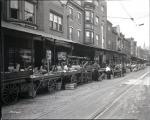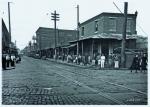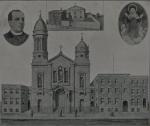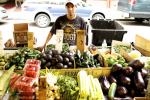![header=[Marker Text] body=[One of several curb markets established in the early 20th century to counter high prices and food shortages during WWI. The 9th St. Market has survived despite anti-immigrant sentiments and criticisms regarding sanitary conditions and traffic congestion. Neighborhood businesses offered fresh produce and a variety of ethnic specialty foods. It has evolved from a local community market to become a popular Philadelphia icon. ] sign](http://explorepahistory.com/kora/files/1/10/1-A-3E1-139-ExplorePAHistory-a0n2l8-a_450.jpg)
Mouse over for marker text
Name:
9th Street Curb Market
Region:
Philadelphia and its Countryside/Lehigh Valley
County:
Philadelphia
Marker Location:
NE Corner of 9th and Christian Sts., Philadelphia
Dedication Date:
October 12, 2007
Behind the Marker
"The more things change, the more they stay the same," goes the popular saying. This is certainly true of areas like Philadelphia's Bella Vista neighborhood and its famous 9th Street Curb Market. Today, visitors will be struck by the rich cacophony of Hispanic and Asian dialectics, the aroma of ethnic foods, and the frenzied labors of a new generation of American immigrants.
The market area-known to generations of Philadelphians as the "Italian Market"-has deep roots in the immigrant experience. No mere melting pot, the market is a testament to the rich diversity of cultures and foodways that have always been a part of the changing ethnic and racial tapestry of Philadelphia and other cities across the United States.
Outdoor markets and stalls were common in early twentieth-century America, a feature of the teeming masses of immigrant dwellers, and the cultural habits and tastes they transplanted from their native countries. Oftentimes, as in the case of the Italian Market, stall owners lived directly above the curbside stall. Business was done on a face-to-face basis with customers who were also your neighbors. And most stalls and shops were family businesses, with multiple generations living and working together at the same location. There was none of the anonymity of today's urban shopping experience. Colorful awnings protected the fruits, fish, meats, vegetables, and household items for sale and drew attention to a particular family's offerings. Curbside competition could be stiff.
Philadelphia's 9th Street market had strong neighborhood roots. The earliest vendors were Jewish and Italian immigrants. Many of the Italians attended the local St. Mary Magdelan De Pazzi Church on Montrose Street, reportedly the first Italian-Catholic parish in the country. As more and more immigrants settled in South Philadelphia along Fitzwater and Christian streets, and Washington Avenue between 6th and 10th Streets, the market area expanded out from its hub along 9th Street. By 1902, more than 70,000 Italian immigrants and their children lived in the Bella Vista district, which was just a short walk from the Washington Avenue Immigration Station. Street festivals commemorating religious holidays and more secular occasions, like the Mummers Day parade and Columbus Day, became regular features of the neighborhood calendar.
Washington Avenue Immigration Station. Street festivals commemorating religious holidays and more secular occasions, like the Mummers Day parade and Columbus Day, became regular features of the neighborhood calendar.
The 9th Street market area reflected the heavy influence of its residents and vendors, even as the shops catered to a growing number of shoppers from beyond the neighborhood. It is hard to imagine a more cosmopolitan or diverse social scene than the market on shopping day. The sights and sounds of America's new pluralism were evident at every turn as customers wandered from stall to stall making their purchases. Here Philadelphia's working poor gathered to purchase their essentials, leaving the high-tone shopping districts of Center City to those with greater economic means.
In places like Harrisburg and Lancaster, which opened its Central Market and Southern Market at the end of the nineteenth century, covered market buildings with rows of stalls provided a different kind of shopping experience. Fresh from the farm, meats and vegetables were on hand, often produced by local Amish and "English" farmers some of whom also shipped produce into Philadelphia, Baltimore, and other regional market centers.
Harrisburg and Lancaster, which opened its Central Market and Southern Market at the end of the nineteenth century, covered market buildings with rows of stalls provided a different kind of shopping experience. Fresh from the farm, meats and vegetables were on hand, often produced by local Amish and "English" farmers some of whom also shipped produce into Philadelphia, Baltimore, and other regional market centers.
Today, many of the 9th Street Curb Market vendors carry on a family tradition that dates back nearly a century. In recent years, however, the market has witnessed several noteworthy changes. Curb stands have been brightened up to appeal to a growing tourist crowd that sees the market as an urban novelty. Hygiene and sanitation conditions have improved substantially, brought about as much by the improved economic standing of the vendors as by regular municipal inspection. And today one is likely to encounter Vietnamese, Hispanic, and other newcomers employed in the businesses, some of whom have opened shops of their own in the changing neighborhood.
Vietnamese, Hispanic, and other newcomers employed in the businesses, some of whom have opened shops of their own in the changing neighborhood.
One element that has stayed the same is the pride of place, which is evident as one walks the pathways of Bella Vista, and the strong and vibrant ethnic cultures that still flourish amidst the hustle and bustle of commercial activity. The Italian Market has been featured in several popular films, most notably Rocky in 1976. A large and colorful mural featuring native son and former Philadelphia mayor Frank Rizzo adorns the side of a building behind the state historical marker commemorating the 9th Street Curb Market. Officials dedicated the marker on Columbus Day 2007, a traditional holiday for Italian Americans across the country.
The market area-known to generations of Philadelphians as the "Italian Market"-has deep roots in the immigrant experience. No mere melting pot, the market is a testament to the rich diversity of cultures and foodways that have always been a part of the changing ethnic and racial tapestry of Philadelphia and other cities across the United States.
Outdoor markets and stalls were common in early twentieth-century America, a feature of the teeming masses of immigrant dwellers, and the cultural habits and tastes they transplanted from their native countries. Oftentimes, as in the case of the Italian Market, stall owners lived directly above the curbside stall. Business was done on a face-to-face basis with customers who were also your neighbors. And most stalls and shops were family businesses, with multiple generations living and working together at the same location. There was none of the anonymity of today's urban shopping experience. Colorful awnings protected the fruits, fish, meats, vegetables, and household items for sale and drew attention to a particular family's offerings. Curbside competition could be stiff.
Philadelphia's 9th Street market had strong neighborhood roots. The earliest vendors were Jewish and Italian immigrants. Many of the Italians attended the local St. Mary Magdelan De Pazzi Church on Montrose Street, reportedly the first Italian-Catholic parish in the country. As more and more immigrants settled in South Philadelphia along Fitzwater and Christian streets, and Washington Avenue between 6th and 10th Streets, the market area expanded out from its hub along 9th Street. By 1902, more than 70,000 Italian immigrants and their children lived in the Bella Vista district, which was just a short walk from the
The 9th Street market area reflected the heavy influence of its residents and vendors, even as the shops catered to a growing number of shoppers from beyond the neighborhood. It is hard to imagine a more cosmopolitan or diverse social scene than the market on shopping day. The sights and sounds of America's new pluralism were evident at every turn as customers wandered from stall to stall making their purchases. Here Philadelphia's working poor gathered to purchase their essentials, leaving the high-tone shopping districts of Center City to those with greater economic means.
In places like
Today, many of the 9th Street Curb Market vendors carry on a family tradition that dates back nearly a century. In recent years, however, the market has witnessed several noteworthy changes. Curb stands have been brightened up to appeal to a growing tourist crowd that sees the market as an urban novelty. Hygiene and sanitation conditions have improved substantially, brought about as much by the improved economic standing of the vendors as by regular municipal inspection. And today one is likely to encounter
One element that has stayed the same is the pride of place, which is evident as one walks the pathways of Bella Vista, and the strong and vibrant ethnic cultures that still flourish amidst the hustle and bustle of commercial activity. The Italian Market has been featured in several popular films, most notably Rocky in 1976. A large and colorful mural featuring native son and former Philadelphia mayor Frank Rizzo adorns the side of a building behind the state historical marker commemorating the 9th Street Curb Market. Officials dedicated the marker on Columbus Day 2007, a traditional holiday for Italian Americans across the country.










